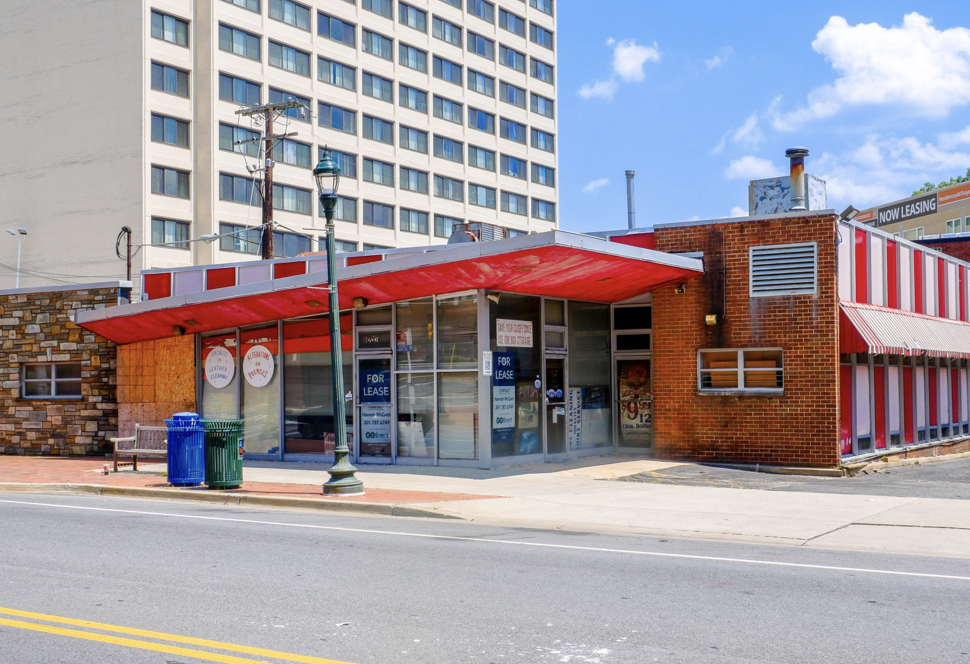
The Montgomery County Planning Board voted to not recommend historic designation for the former Weller’s Dry Cleaning site in Silver Spring at a public hearing on Thursday, February 23. The County Council makes final decisions on historic designations of properties in the county. The site was part of a proposed amendment to the county’s Master Plan for Historic Preservation. Read the amendment. Watch the video from the February 23 Planning Board public hearing.
About the former Weller’s Dry Cleaning site: The former Weller’s Dry Cleaning site (8237 Fenton Street, Silver Spring, MD) was originally identified for evaluation as an historic resource over twenty years ago in the 2002 Historic Sites Survey Report: Silver Spring Central Business District. The 2022 Silver Spring Downtown and Adjacent Communities Plan directed Montgomery Planning to evaluate the Weller’s Dry Cleaning site designation as a Master Plan Historic Site. This site consists of a Googie-styled commercial store and sign constructed in 1961 within the Thayer Avenue commercial area in Downtown Silver Spring. The Googie style is a popular, but relatively rare, mid-20th century roadside commercial architecture that is a subset of the Modern Movement of architecture. Architects popularized the style in California where the intention was to attract motorists traveling at 35 miles per hour or more to stop and patronize roadside businesses. The design of the former Weller’s Dry Cleaning building and sign engaged the everyday consumer with modern and popular architecture in lieu of the high-style austerity of the International, Brutalist, and Expressionist styles. Very few examples of this architectural style remain intact in the county or region. View the December 2022 Weller’s Dry Cleaning Master Plan for Historic Preservation Designation Form.
Background: In 2022 the Historic Preservation Commission (HPC) found that the site met the requirements in the County Code to be designated through its evaluation process. The HPC then recommended the Montgomery County Planning Board review and recommend that the County Council designate both sites as historic. The County Council has the final authority on the decision to designate a site as historic.
About the historic preservation process: Designating a place for historic preservation is based on criteria set forth in Chapter 24A-3 of the County Code. The decision to designate a property begins with a completed research form from The Maryland Historic Trust and is reviewed by the Historic Preservation Commission (HPC), the Montgomery County Planning Board, and the Montgomery County Council. The County Council has the final say on what gets designated historic. When the County Council includes a property in the Master Plan for Historic Preservation, all changes to the outside of the property must be reviewed by the HPC before issuing any permits. Examples of current Master Plan Historic Sites and Districts include:
- Archeological sites and mill ruins along stream valleys
- Farms, banks, and meeting houses, associated with the Quaker heritage
- Lock houses, aqueducts, mines, and quarries, boarding the Potomac River and the Chesapeake & Ohio (C&O) canal
- Rivers fords and encampment sites of the Civil War
- Early African American communities
- Early suburbs developed along the route of the Baltimore & Ohio (B&O) railroad
- Small-scale commercial blocks and gas stations from the early automobile era
- Major government complexes such as the Bethesda Naval Hospital and the National Institute of Health
- Postwar housing that shaped suburban development
The Locational Atlas and Index of Historic Sites: The Locational Atas and Index of Historic Sites is the Planning Board’s inventory document of sites that are potentially significant and should be considered further for listing in the Master Plan for Historic Preservation. The Planning Board may take action to list a site to the Atlas pending further review of its historic significance by the Council. Locational Atlas listing protects a property from demolition and substantial alterations under Chapter 24A-10 of the County Code.
About the Historic Preservation Office: The Montgomery County Planning Department’s Historic Preservation Office (HPO) identifies, protects, and explores historically significant built places throughout the county, ultimately preserving the past to enrich the future. HPO is responsible both for administering regulations around designating and maintaining historical sites and for digging into the county’s history to better inform the decision makers planning our future.
As part of Montgomery Planning, HPO constantly strives to help improve the natural and built environments of Montgomery County. The county’s historic fabric has irrevocably informed every corner of the county, from the Ag Reserve to Silver Spring, and understanding HPO’s role is a critical part of planning. Americans are aware of such public history in ways that they have not been in a generation, and HPO aims to share that history as broadly as possible.
Though the Historic Preservation Office focuses on the built environment (which distinguishes us from other historic societies), HPO also has resources for genealogy, tax credits, and more. From restoring and promoting specific sites to painting a more complete picture of the diverse people and places that shaped—and continue to shape—the modern Montgomery County, HPO helps ensure that future plans are informed by and reflected in a thorough, critical appreciation of what came before. History lives with us in the present.
Recent Stories
U.S. Customs and Border Protection have announced the arrest of a 26-year-old Texas woman after almost 43 pounds of marijuana in her luggage at Washington Dulles International Airport last Thursday.
The Maryland Transportation Authority is replacing the deck on the Bay Bridge. This portion of Phase 1 deck replacement recently began with anticipated completion by spring 2025.
FEST OF SPRING Caribbean Wine Food & Music Festival
Get ready to experience the vibrant colors, tantalizing flavors, and infectious rhythms of the Caribbean at the FEST OF SPRING Caribbean Wine Food & Music Festival! Hosted by RHU LLC, this exciting festival is set to take place on May 18, 2024, at the picturesque 16700 Barnesville Rd in Boyds, MD.
Step into a world where the Caribbean spirit comes alive! From 12:00 PM onwards, immerse yourself in a sensory journey that celebrates the unique culture, cuisine, and music of the Caribbean. Whether you're an African American, a Reggae or Soca music enthusiast, a wine lover, or part of the vibrant Caribbean diaspora, this festival promises to delight and captivate you in every way.
Let the enticing aromas of mouthwatering Caribbean dishes tantalize your taste buds. Feast on traditional delicacies prepared by expert chefs, showcasing the rich and diverse culinary heritage of the Caribbean. Indulge in flavorful jerk chicken, succulent seafood, and delectable plantain dishes that will transport you straight to the islands.
Accompanying the culinary extravaganza is a carefully curated selection of premium wines, ensuring the perfect pairing for your palate. Sip on fine wines from renowned vineyards, each sip a reflection of the Caribbean's vibrant spirit. Discover new flavors, expand your wine knowledge, and savor unforgettable moments with every glass.
As the sun sets, get ready to groove to the infectious rhythms of Caribbean music. Feel the pulsating beats of reggae, soca, dancehall, and calypso, moving your body to the lively melodies. Live performances by talented musicians and performers will keep the energy high, ensuring a night of unforgettable entertainment.
Don't miss this opportunity to embrace the Caribbean spirit and celebrate the arrival of spring in style! Tickets are available on AllEvents, so secure your spot today. Join us at the FEST OF SPRING Caribbean Wine Food & Music Festival, where cultures collide and unforgettable memories are made.
LIVE PERFORMANCES By: CULTURE Feat. Kenyatta Hill, EXCO LEVI, IMAGE BAND, RAS LIDJ REGG'GO with Special Guest SUGAR BEAR FROM E.U. & MORE! & MORE!
MUSIC By: DJ ABLAZE, DJ SMALLY & NAJ SUPREME
2 NIGHT Camping packages available: RV/CAMPER $200 | TENTS $150 Starting on Friday May 17 @ 5pm | 30 RV SPACES | 30+ TENT SPACES
KIDS 12 & UNDER FREE!!!




